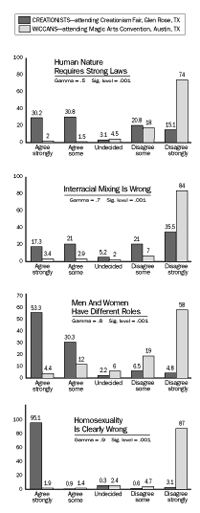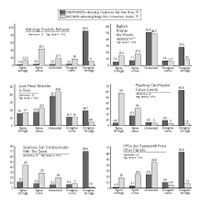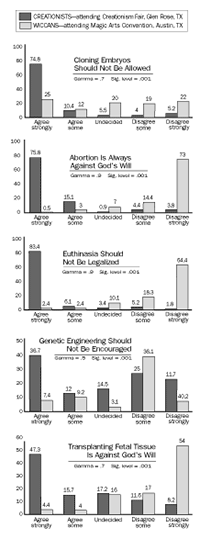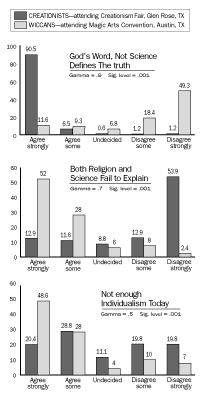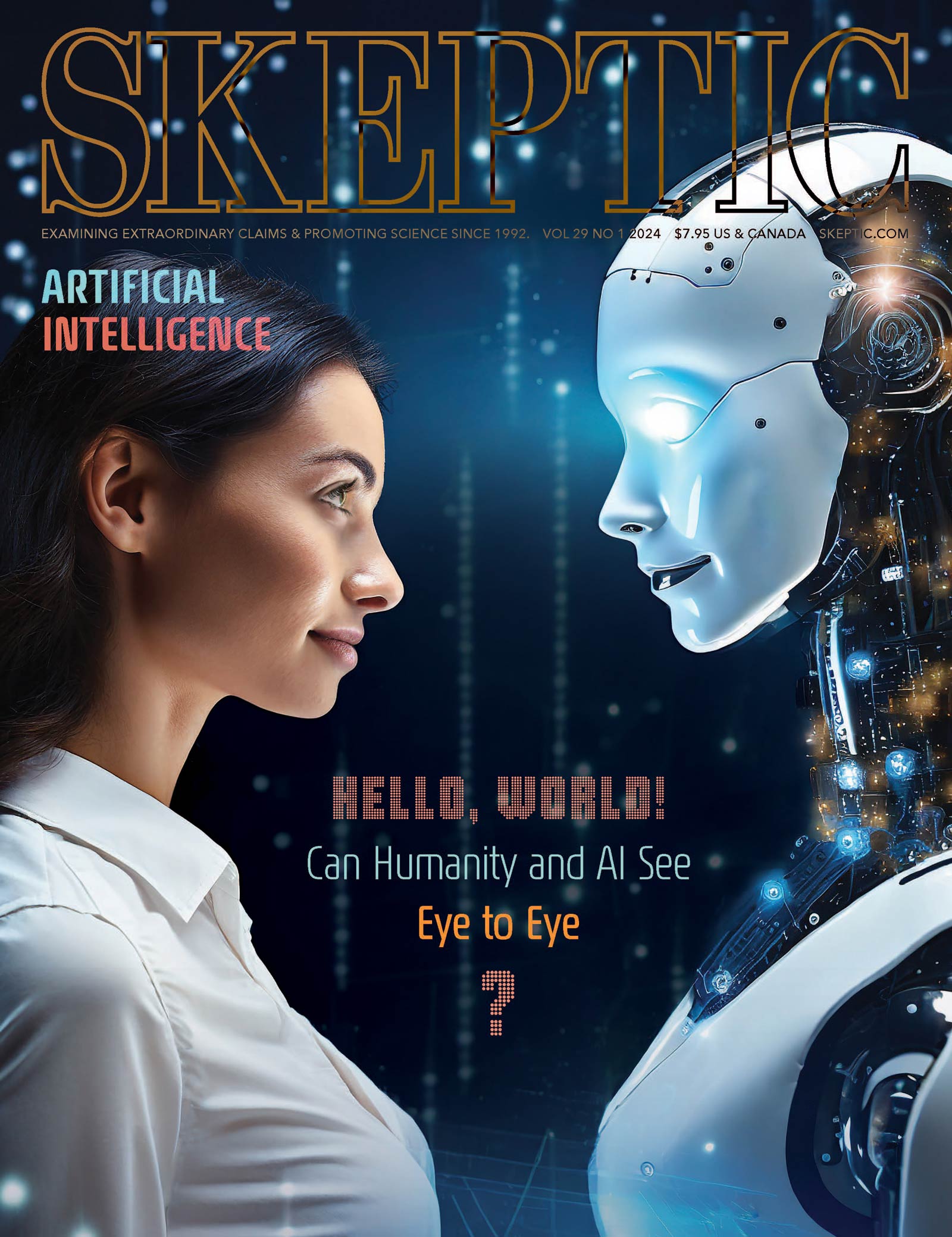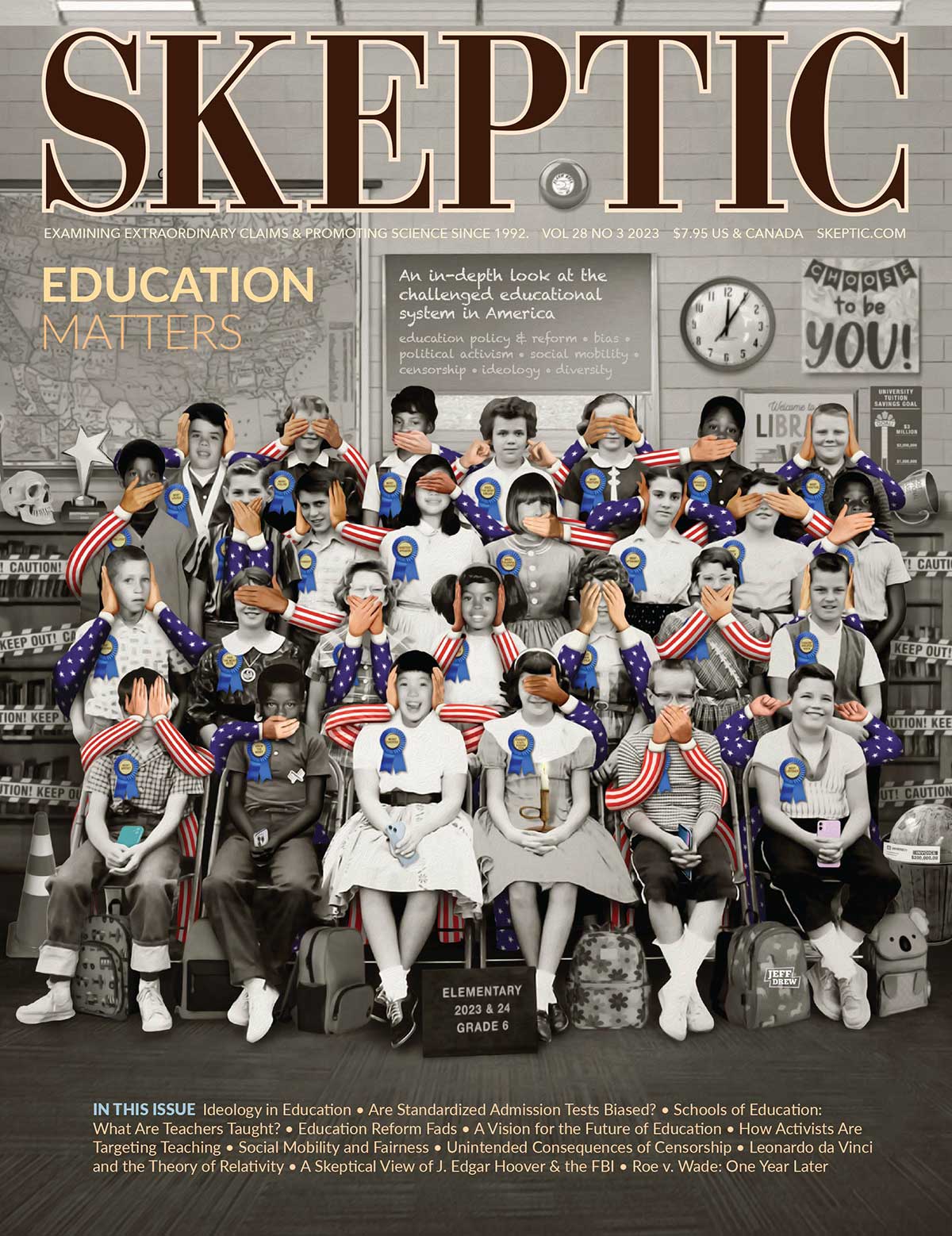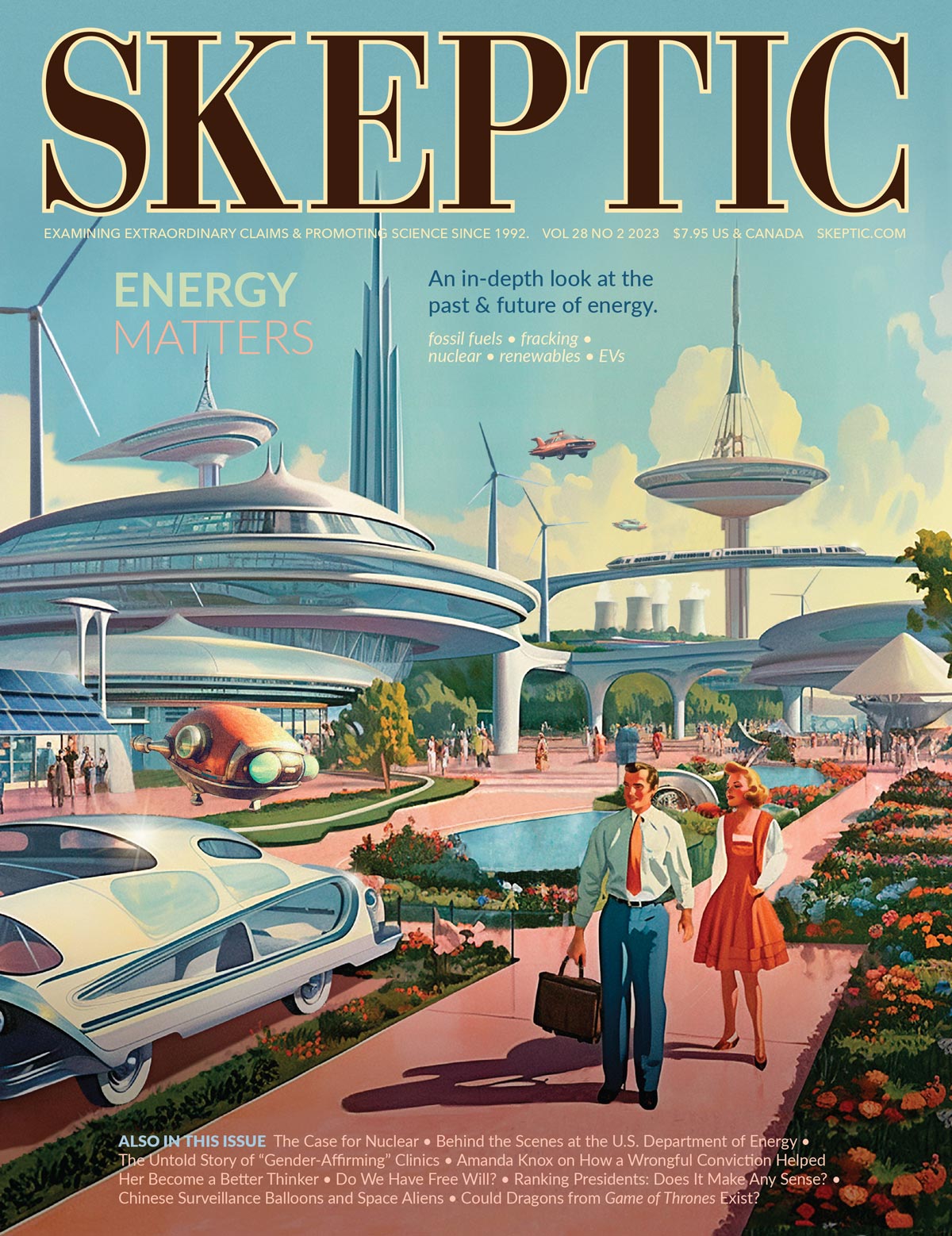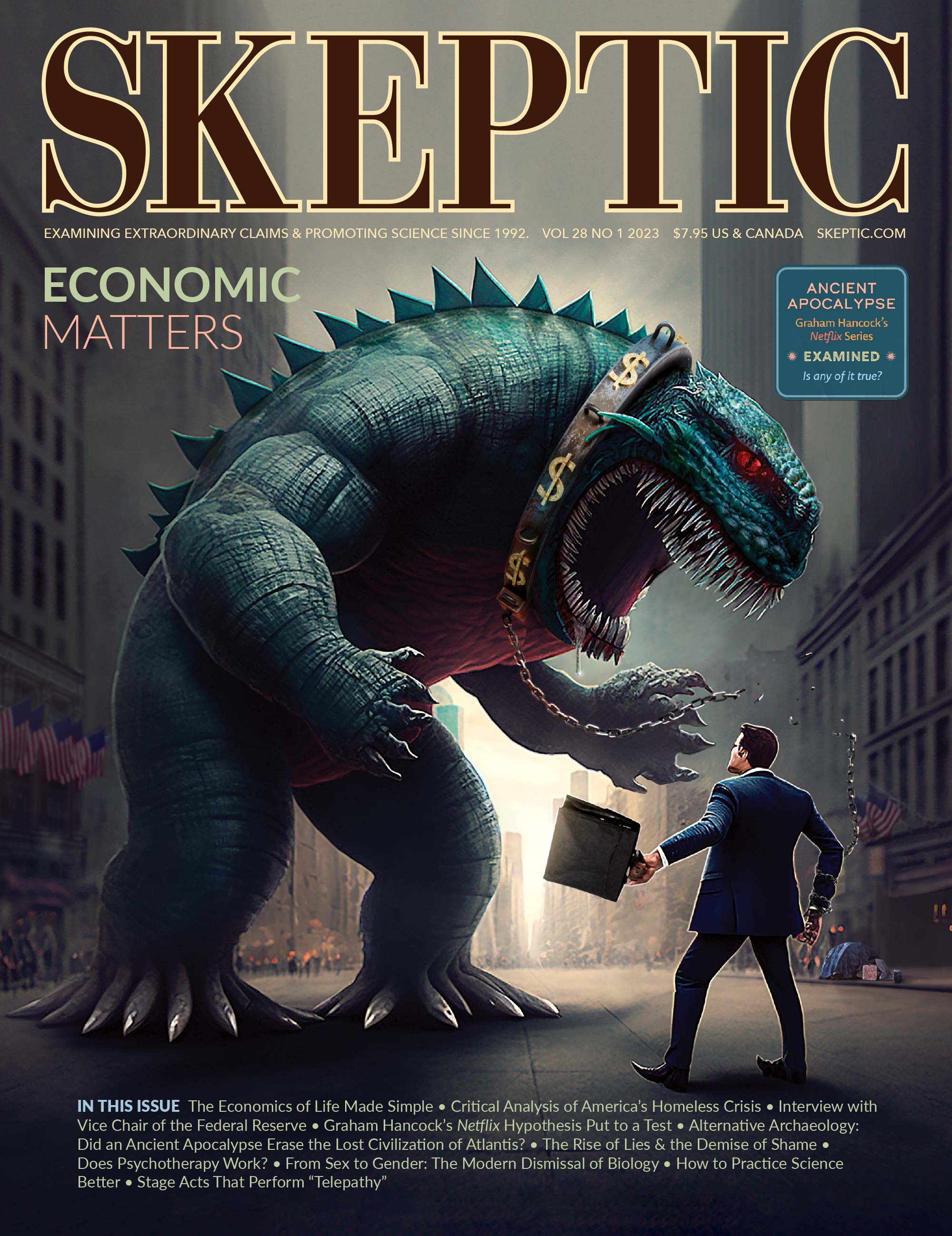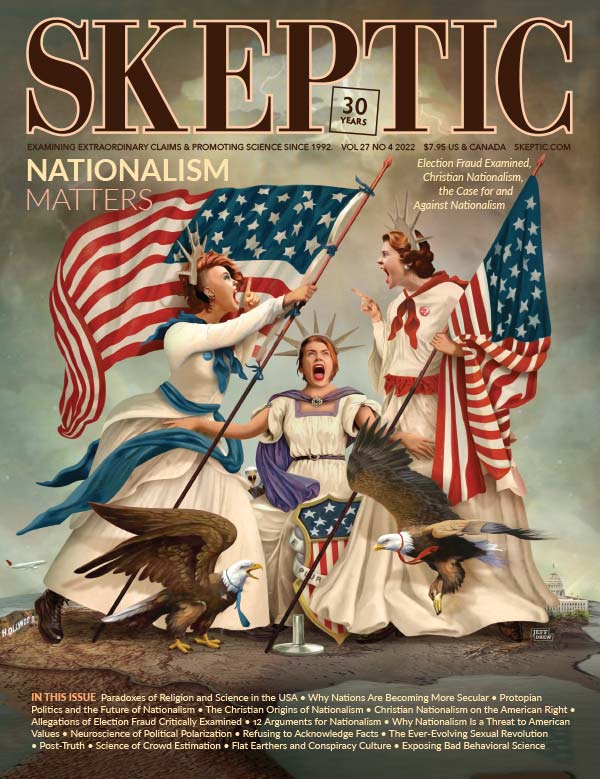In this week’s eSkeptic:

Packing for Mars
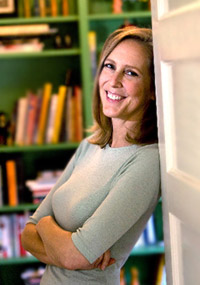
Imagine you were talented enough, ambitious enough and lucky enough to be chosen to be part of a manned mission to another planet. What might you see out there? What might you learn?
And, what about going to the bathroom, taking a shower, eating, drinking, sleeping, or even sex?
This week on Skepticality, Swoopy talks with psychologist, journalist and bestselling author Mary Roach. Her new book Packing for Mars: The Curious Science of Life in the Void explores how space programs, scientists and astronauts (and even astro-chimps) tackle the unexpected complexity of performing everyday activities when in space.
As with her previous books Spook (the science of the search for the afterlife), Stiff (the science of the dead), and Bonk (the science of sex), Ms. Roach’s accessible investigation into the science of space travel sparkles with humor and insight.
In this week’s eSkeptic, Raymond A. Eve discusses an empirical study of the difference between the beliefs of wiccans versus those of creationists.
Dr. Raymond A. Eve received his Ph. D. from the University of North Carolina at Chapel Hill. He is currently Professor of Sociology at the University of Texas at Arlington where he teaches courses in social movements, the social study of science, and special topics in science and religion. He has published widely on pseudoscience, bogus archaeological claims, and the creationist movement both inside of the U.S. and elsewhere. He has also published the book Chaos, Complexity, and Sociology: Myths, Models, and Applications and remains involved in the study of nonlinear dynamical modeling in the social sciences.
Wiccans v. Creationists
An Empirical Study of How Two Systems of Belief Differ
by Raymond A. Eve
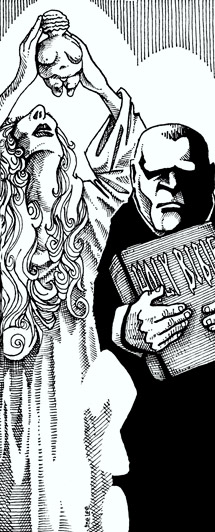
In a 1991 book entitled The Creationist Movement in Modern America,1 Frank Harrold and I ran through the gamut of explanations for why people believe in special creationism, or the belief that the Earth and life were created about 10,000 years ago. (About 40% of Americans believe in both creation and evolution — that evolution was guided by God and that the process took billions of years. These people are sometimes called theistic evolutionists, or old earth creationists, and contrast sharply with young earth creationists.2) When I use the term creationists, it is in reference to the special, or young earth creationists.
Initial explanations attributed creationists’ beliefs to some sort of pathology. For example, in the aftermath of a 1974 controversy in Kanawha, West Virginia, triggered by the introduction of a new series of Language Arts books for use in the public schools (that included evolution “presented as a fact”), the headmaster of the new reading program, James Moffitt, rendered his opinion. In a book he authored on the incident,3 Moffitt attributed the source of anti-evolutionism to “authoritarian personalities.”4 Another popular explanation is that creationists are ill-educated ignoramuses, or backwoods bumpkins.
However, even if it were true that some creationists display a higher proportion of pathological traits than one would expect by chance, this not an adequate explanation. Frank Harrold and I, for example, collected a mass of survey information from a multitude of sources in which the data clearly demonstrated that explanations based on personal pathology could not account for a plurality of creationists. Instead, most of them appeared adequately-to-well educated, and generally seemed to be no more pathological than the rest of us. It may be that academic social scientists (who typically lean toward being politically liberal) are too quick to assign negative personality traits to adherents of conservative beliefs.5
Cultural Traditionalists, Modernists, and Postmodernists
An important sociological understanding of the origins of creationism was presented in 1978 by Ann Page and Donald Clelland, who suggested that conflicts such as the one that occured in Kanawha County could best be understood as a group-level phenomenon rather than a purely individual matter, and that these differences of opinion reflect conflicting worldviews held by each groups.
Page and Clelland labeled one such aggregate “cultural fundamentalists,” or what I prefer to call cultural traditionalists — those who tend to employ a literal reading of scripture. (I prefer this label because Harrold and I found many creationists who live outside of the so-called “fundamentalist” religious denominations.) For cultural traditionalists what is good or evil is not up to humans to decide — God’s revealed commandments uniquely serve that purpose. Additionally, cultural traditionalists see the purpose of life as to serve and glorify God, even if this means one must submit one’s own being to hardship and toil. A second aggregate, termed “cultural modernists” by Page and Clelland, is described as being the paradigmatic descendants of the Enlightenment and secular empiricism. As such, cultural modernists are said to believe that the road to truth lies in gathering data with which to test hypotheses, and then let the philosophical chips fall where they may.
As an example of the conflict of these two groups, consider the question “What is to be done about AIDS?” Cultural traditionalists sometimes see AIDS as God’s will. (For example, in the opinion of many traditionalists, AIDS is weeding out drug-users, homosexuals, and prostitutes from society at large). Even at its most liberal, however, cultural fundamentalism would “hate the sin and love the sinner.” In either case, traditionalists would say that the cure for AIDS would be to return to greater piety and commitment to biblical values and injunctions. Contrast this perspective with that of cultural modernists, who argue that the cure for AIDS involves conducting epidemiological studies to find its cause, and preventitative methods such as condoms and sterilized needles as part of a development of a technology-based cure.
Compared to modernists, cultural traditionalists have been shown to be a fairly homogenous group — specifically, they are more rural, older, white, and Protestant. In contrast, cultural modernists seem to have arisen in part, out of necessities brought about by urbanization and widespread migration. For example, cultural modernists seem to accept the idea that different people from different backgrounds are likely to be crowded together in today’s societies, and that cosmopolitan values and multicultural acceptance are therefore necessary in order to avoid mass crime and bloodshed. However, this view also leads them to speak of homosexuality and women priests as “alternative lifestyles.” Cultural traditionalists would answer that there is nothing “alternative” about lifestyles, which they believe God condemns.
In general, for cultural modernists, truth claims are assessed in light of data, hypothesis testing, and logical reasoning. For cultural traditionalists, truth claims are strictly evaluated in terms of tradition, authority, and scriptural demands. (In the words of one of our respondents, echoing a popular bumper sticker among conservative Christians, “God said it, I believe it. That’s the end of the argument!”)
Into the mix we can add a third orientation to assessing claims — postmodernism, which encompasses a broad array of subtypes, from holistic health followers, to New Age believers, to many academicians. Despite this range of diversity, postmodernists are largely defined by what they are not — they are not traditionalist, nor are they modernist. In other words, they can be grouped by their rejection of the other two common paradigms of our times. But they can also be classified as believing that “grand narratives” have no validity. Grand narratives represent all encompassing accounts of human existence, typically a single great Truth that exists external to any individual. Grand narratives can be political or psychological theories (such as Marxism or Freudianism), or they can be the specific doctrinal tenets of the world’s major religions. The key point is that for postmodernists, all such grand narratives are to be rejected in favor of the belief that the truth, to the extent that it even exists, is highly individualistic, subjective, and to be found largely within each person.
Wiccans as a Control Group
Creationists believe in their version of origins because they are cultural traditionalists. But traditional compared to what? To test this hypothesis I needed a control group. I chose the Wiccans — contemporary followers of so-called “Goddess” religions.6 Wiccans typically reject Christianity and other mainstream religions as being too patriarchal in nature.7 A high proportion of neopagans in general, and Wiccans in particular, assert that excessive masculinity led to the ecological rape of the planet. Wiccans see Christianity as a religion that originated from the myths of ancient Hebrew pastoral tribes. Such tribes were notoriously patriarchal, and Wiccans believe this patriarchy is still deeply embedded within modern Christianity.8
Wiccans argue that Christianity has either purposely or inadvertently supported Sir Francis Bacon’s views of science and technology. (Unfortunately, Bacon occasionally used language that could be construed as sexist by today’s standards. For example, he spoke of nature being in need of “unveiling” and “penetration.”) Wiccans also suggest that the language and imagery of the Bible places women into a subservient category, and this is due at least in part to Eve being blamed for humanity’s fall from Paradise.
Wiccans have tried to remedy such ills by restoring a sense of the divine to femininity.9,10 They see themselves as returning to the practice of “white magic” (that they believe existed before the rise of modern Christianity). According to one of the initial literary treatises of Wicca, entitled The Spiral Dance,11 Wiccans practice magic for the good of individuals and the community, and they base their religious rituals upon the cycle of the seasons.
Many outside observers have labeled neopagans as “New-Agers.” Wiccans, however, prefer to consider themselves of the “Old Age,” by which they mean they are returning to ancient religious and spiritual practices which they believe allow them to tap into subtle but powerful natural forces. They assert that there are forces of nature that are susceptible to manipulation by magic. However, they believe that the conditions of modernism have seperated us from nature so that we have lost our abilities to perceive and manipulate these Old Age powers. I label Wicca as a postmodern religion primarily because of its contention that deity is within each of us, and that truth is different and subjective for each practitioner. For example, Wicca allows a follower to be anything else they wish to be religiously, and still be a Wiccan. We can also argue that Wicca’s emphasis on rituals dedicated to restoring ecological balance, and emphasis on gender equality,12 are consistent with postmodernism as it is widely defined.
Testing Creationists and Wiccans
In confronting the challenges of modern life, how do the members of each of our three groups cope? Cultural traditionalists tend to seek God’s favor by advocating a return to older norms and values, most especially to greater Christian piety. Cultural modernists employ empirical data and scientific inquiry, plus rationalized planning, production, and administration. Postmodernists (at least those outside of academia) attempt to empower themselves through “technologies” largely derived from pre-Christian practices and non-Christian worldviews (such as psychic healing, soul travel, crystal powers, etc.).13
Before conducting my study, I predicted that cultural traditionalists would be the respondents most likely to support religiously- and politicallyconservative worldviews and social agendas (because of their faith in tradition and authority). I also predicted that postmodernists were likely to hold beliefs that skeptics would consider to be pseudoscience. For many postmodernists, psychic powers, astral projection, and communication with spirits are believed to be useful “technologies,” and hence a means of empowerment.14 It is precisely this latter concept that is intended by the term “witchcraft” in anthropology. That is, in cross-cultural studies, witchcraft has little to do with the Devil, but instead has everything to do with trying to use a “metaphysical technology” to bring about desired outcomes.15
In order to test these predictions, two sets of data were collected. For the first, anonymous questionnaires were distributed to 328 people who attended a “Creationism Fair” in Glen Rose, Texas, during a weekend in 1995. The site was largely chosen because of its proximity to Texas’ Dinosaur State Park. (The significance of the park is that it is the home of the famous “Paluxy River Man Tracks,” indentations in the bottom of a limestone streambed that lie next to fossilized dinosaur tracks that are claimed by some creationists to be human footprints.) Just outside the main entrance to the park is the home of “Dr.” Carl Baugh’s Creation Evidences Museum,16 well known to creationists for its extensive set of exhibits intended to demonstrate scientific legitimacy for creationist claims, including a 10,000-year old Earth. Ironically, it was Baugh and Don Patton who distributed the questionnaires (Don Patton was, at the time, the President of the Metroplex Institute for Origins Studies, another creationist organization).17,18
Data from a second sample were collected late in 1995 at a “Magic Arts Convention” just outside of Austin, Texas. At that event there was a gathering of nearly 300 neo-pagans, primarily Wiccans. They held religious rituals, shared a sense of community, and sold various pagan and New Age wares to each other. A total of 215 people who identified themselves as Wiccans completed the questionnaire.19,20
Data Differences Between Creationists and Wiccans
Demography. In this dataset, creationists were older than Wiccans, with 56% percent over 40 years of age, compared to 22% of the Wiccans. No Wiccan was over 60 years old. Creationists tended to be more likely to have grown up in small towns and rural places, whereas Wiccans came from more urban environments. The education levels for Creationists and Wiccans were roughly the same (47% and 46%, respectively, attending college), although there were differences in parental education levels. Creationists’ fathers’ modal educational attainment level was high school. In contrast, the mode for the fathers of Wiccans was a college education (with more than one out of five of the fathers having attended graduate school, compared to about one of ten for the creationists; the same general pattern held for respondents’ mothers). For both creationists and Wiccans, there was a tendency for their parents to have been Protestants more than any other affiliation, but this was especially true of the creationists. Wiccans from non- Protestant families were more likely to report that their parents were Catholics, non-religious, or of fairly uncommon religious persuasions.21 Surprisingly, the proportion of female Wiccans (51%) was roughly the same as female creationists (48%).
Civil Religion. Civil religion is the belief that Americans as a people are bound together by sacred ideals, sacred character, and that God has blessed the nation with a special place in world history. Creationists, as predicted, show strong support for civil religion. For example, when asked if “Everyone should support this country,” 38% of creationists strongly disagreed, compared to 59% of Wiccans. Similarly, when both groups were asked if “The schools should require students to say the Pledge of Allegiance to the United States,” 85% of creationists supported this, compared to only 14% of Wiccans. For creationists, there is relatively little distinction made between scriptural religion and civil religion.
Social conservatism. The tendency for creationists to enforce tradition extends far beyond civil religion. For example, when asked if “Human nature requires strong laws,” 61% of creationists felt this was so, but only 3% of Wiccans held that view. Similarly, only 35% of creationists strongly disagreed that “Interracial mixing is wrong,” but 84% of the Wiccans rejected the same statement. The creationist preference for orthodoxy extended to the matter of gender roles as well. When asked if “Men and women have different roles in society,” 87% of creationists agreed, but only 16% of Wiccans agreed. Most strikingly, when asked if “Homosexuality is clearly wrong,” 95% of the creationists agreed, compared to a mere 2% of Wiccans. It seems safe to conclude that Wiccans are more likely to approve of “alternative lifestyles,” whereas creationists appear to believe that literal biblical strictures concerning proper behavior are ignored at great peril.
Paranormal Beliefs. If, as is clear from the data, we can classify creationists as enforcers of tradition, we might predict that they would eschew unconventional paranormal beliefs when compared to Wiccans. This is, indeed, what the data show. When asked if astrology is an accurate predictor of human behavior, 93% of creationists disagreed, compared to only 25% of Wiccans. Although both groups have around half of their members who aren’t sure if “Bigfoot roams the woods of the Pacific Northwest,” 35% of creationists completely reject the idea, compared to only 14% of Wiccans. When asked if “The Loch Ness monster is real,” creationists rejected the existence of the creature 29% of the time, but Wiccans did so only 14% of the time. When asked if it is true that “Psychics can accurately predict the future,” 58% of Wiccans strongly agreed, compared to only 5% of creationists. A similar result was obtained when member of both groups were asked if “Séances can communicate with the dead.” 68% of creationists strongly disagreed such a thing was possible, but only 1% of the Wiccans strongly disagreed. Asked if “UFOs are actual spacecraft from other planets,” 61% of creationists strongly disagreed, compared to only about 7% of Wiccans.22
Social and Science Attitudes. I have written elsewhere about the existence in literature of what I like to call “cautionary tales,” or writings that warn of the dangers of recent breakthroughs in science, or warn us about the use of new technologies. Frankenstein is the holotype in this genre. As cultural traditionalists, creationists, I predicted, should view science with caution more often than Wiccans. When both groups were asked if “Cloning embryos should not be allowed,” 75% of creationists strongly agreed, compared to 25% of Wiccans. A similar response pattern can be seen in the statement “Genetic engineering should not be encouraged.” 37% of creationists strongly agreed, compared to 7% of Wiccans. Most striking, but not surprising, when asked if “Abortion is always against God’s will,” three-fourths of creationists agreed strongly, compare to less than one percent of Wiccans! When asked if “Transplanting fetal tissue is against God’s will,” we find few respondents in the middle categories for either sample — the vast majority of creationists strongly agreed with the statement, while an equally vast majority of Wiccans disagreed. The same pattern is found for the question “Euthanasia is against God’s will” — nearly all the creationists agreed, nearly all the Wiccans disagreed.
Science and Religion Attitudes. Recall that we began with the question of whether pseudoscientific beliefs are the result of ignorance and mental aberration, or are they the end product of a way of thinking embedded in a worldview? The data here support the latter. When asked if “It’s God’s word, not science, that defines the truth,” 91% of creationists agreed, while only about 20% of Wiccans agreed, and half of them strongly so. Insight into Wiccans’ worldview can be seen when asked if “Both science and religion fail to provide us with the answers to the important questions facing us today.”
80% of Wiccans agreed that neither could be counted on for solid guidance, whereas creationists rejected the same statement two-thirds of the time. Here, Wiccans’ response was consistent with the earlier suggestion that Wicca, while preferring to think of itself as “pre-modern,” actually fits the paradigm of postmodernism rather well.23 In other words, Wiccans do appear to believe that truth is largely a matter of individual processes internal to each person, and one is free to pick and choose the bits of theology that work for them.
Additional support for the suggestion that Wicca is a postmodern religion comes from the chart in Figure 4 where both groups were asked if it is true that “There is not enough individualism today.” Almost half of Wiccans strongly agreed, and this was a considerably higher proportion than among creationists. It would appear we are safe in concluding that instead of adhering to an external code based on authority, tradition, and revelation (as chosen by creationists), Wiccans instead place more emphasis on their “One Commandment” that says “And if it harms none, do as thou wilt.”24
Summary and Conclusions
What can we conclude from these survey data? First, we are left with the understanding that the origin of paranormal beliefs often arises through normal group dynamics and is not simply the result of ignorance or mental pathology. Singer and Benassi,25 among others, have suggested multiple origins for paranormal beliefs, for example, common errors in human reasoning, poor science education, sensationalistic media coverage of science, and sociocultural factors. This study strongly supports the latter causal variable.
Rapid rates of social change in the U.S. seem to have left multiple (but frequently incompatible) sets of rules for assessing the nature of reality. Once one understands the set of rules associated with each worldview, many paranormal beliefs logically follow. However, we should realize that it is not clear that these worldviews are always congruent with specific groups. Surely some aggregates, such as creationists and Wiccans, are likely to be fairly homogenous in outlook. However, we need to be mindful that these two groups were deliberately chosen with the expectation that they would be both extreme and diametrically opposed in their choices of epistemological rules for knowing.
In general, it may be better to argue that these differences are not so much about aggregates as they are about different ways of understanding reality that are available in the culture to all of us. Rapid social change has spun off several sets of heuristics within mere decades. This might help to explain, for example, why a student might be a cultural modernist in a biology lab, but a cultural traditionalist a few hours later upon returning to a rural hometown for the holidays. Most of us, in other words, may subconsciously switch among these worldviews, and we may oft-times do so without conscious awareness.
References
- Eve, Raymond A., and B. Harrold Francis. 1991. The Creationist Movement in Modern America. Boston: Twayne Press.
- Special creationists derive their dates for human origins from Irish Archbishop Usher who, in the first half of the 17th century, concluded from a literal reading of the Old Testament that the world was created in 4004 B.C.
- Moffett, J. 1988. Storm in the Mountains. Carbondale, IL: Southern Illinois University Press.
- In case the reader is unfamiliar with the origin of the idea of the authoritarian personality, further information can be found on the following website: http://tinyurl.com/23fyy4c
- It was for this reason that social psychologist Milton Rokeach developed his wellknown dogmatism scale. Rokeach hypothesized that liberals were often as rigid in their beliefs as conservatives. There is a study in the online journal of the Creation Social Science and Humanities Society, that appears to demonstrate that creationist students are no more dogmatic than their noncreationist counterparts. See: www.creationism.org/csshs/v04n3p15.htm
- “Wicca” comes from the ancient Gaelic term for “the craft,” meaning witchcraft.
- Stone, Merlin. 1976. When God was a Woman. New York: Dial Press. Note that a number of scholars such as religious historians and anthropologists (including some female authors) have pointed out there probably never was a time in antiquity when “God” would have been an individual female entity. Instead, in ancient times, just as male monotheism did not exist, neither did female monotheism. See: Allen, Charlotte. 2001. “The Scholars and the Goddess.” The Atlantic Monthly. January. 18–22.
- Berger, Helen A. 1999. A Community of Witches: Contemporary Neo-paganism and Witchcraft in the United States. University of South Carolina Press.
- Although much is made in the media of Wicca as a “Goddess religion,” in reality Wiccan theology officially calls for the worship of both the Great Goddess and the male Horned God (not to be confused with Satan). These are both seen as necessary and complementary (such as Yin and Yang). All traditions of Wicca (there are several) believe that the correct image of the Divine must comprise both male and female. For Wiccans, to worship either sexual aspect alone would create imbalance, and much of Wicca revolves around ritual attempts to balance the forces of nature as well as one’s personal life.
- Adler, Margot. 1997. Drawing Down the Moon: Witches, Druids, Goddess-Worshippers, and other Pagans in America Today. New York: Penguin.
- Starhawk. 1979. The Spiral Dance: A Rebirth of the Ancient Religion of the Great Goddess. San Francisco: Harper and Row.
- Orion, Loretta. 1995. Never Again the Burning Times: Paganism Revived. Prospect Heights, Illinois: Waveland Press.
- We will focus here primarily upon postmodernists outside of academe. As a point of interest, academic postmodernists seem less interested in empowering themselves than in disempowering the rhetoric of modernists through the “deconstruction” of the modernist’s rhetoric or “text.” Curiously, almost no deconstructionism of this type is directed at cultural traditionalists.
- These tools for empowerment have the added advantage of not requiring years of difficult and competitive study of physics, chemistry, mathematics, anthropology, and so forth.
- A good example of what is meant here by metaphysical technology can be seen in Malinowski’s famous study of the Trobriand Islanders. These islanders made their living largely by fishing. Malinowski noted they did not perform magic in protected lagoons, but only when they first paddled out into the open ocean, which sometimes threatened to overwhelm their small boats. The lesson seems obvious: humans invoke their gods when the physical technology seems inadequate to the task at hand. How tempting, then, to employ a metaphysical technology to attempt to control the uncontrollable. See: www.vanderbilt.edu/AnS/Anthro/Anth206/malinowski.htm
- Dr. Baugh’s terminal degree appears to have been granted from a lone-standing frame house in Dallas. For more on this, and a skeptical perspective on the Museum, see: www.ntskeptics.org/2000/2000january/january2000.htm. You can also find information about the Creation Evidences Museum at their web page: www.creationevidence.org/cemframes.html
- When they learned of interest by researchers from a University they welcomed the chance to help in the data collection. They seemed secure in their belief that the results would advance the creationist cause. Large numbers of Fair attendees were ushered into an enclosure to view a film on creationism. At the end of the film, Dr. Baugh or Mr. Patton distributed the questionnaires and exhorted those receiving them to cooperate in the study. We hope, of course, that this largely eliminated any bias that might have occurred if university researchers had distributed the surveys.
- I would like to thank Mr. John Taylor, who was at that time a graduate student working with me, for much of the actual labor of collecting, coding, and performing computer analyses on the creationist data.
- It is worth noting that both in Glen Rose and in Austin, respondents appeared eager to fill out questionnaires. Both groups seemed to feel a need to put their views before a wider audience, and welcomed the chance to do so.
- I would like to thank Ms. Ladorna Goff, at that time an outstanding undergraduate, for much of the actual labor of collecting, coding, and performing computer analyses on the Wiccan data.
- The demographic profiles of creationists differed from that of Wiccans in ways that many previous studies have found to be typical. For example, Joseph Gusfield found that members of the 19th-century Temperance and Prohibition movements fit the pattern of being older, more rural, and less educated. Louis Zurcher found a similar profile when he examined anti-pornography crusaders during the 1960s. Other research since then has generally found the same pattern among adherents of conservative social movements, such as those in favor of prayer in school, or against school sex education, or against gay rights, abortion, and the legalization of marijuana. Creationism appears to be as much about defending or promoting a certain lifestyle, as it is a matter of good scientific evidence. See: Gusfield, Joseph R. 1963. Symbolic Crusade: Status Politics and the American Temperance Movement. Urbana, IL: University of Illinois Press. Zurcher, L. A. 1971. “The Anti-Pornography Campaign: A Symbolic Crusade.” Social Problems, 19: 217–38.
- Similarly, when asked if “UFOs built the pyramids,” only one-third of Wiccans strongly rejected the idea, but 86% of the creationists strongly disagreed.
- This individualism is sometimes called “Sheilaism.” Robert Bellah and colleagues, in their book, Habits of the Heart, tell of a young nurse, Sheila Larson, who, when asked about her faith, replied that she was religious but seldom went to church, and apparently preferred a sort of “mix-andmatch” amalgam of bits and pieces of various theological stances. Famous scholar of religion and author Wade Clark Roof said this is representative of a trend where “self and deity become fused into one. Americans generally, it seems, have grown more individualistic and subjectivistic in their faiths in the post-1960s period.” See, www.esmhe.org/Plumbline/v1n1/roof.html
- For further information on the One Commandment, see: www.religioustolerance.org/wic_term.htm
- Singer, Barry and Victor Benassi. 1981. “Occult beliefs.”American Scientist, 69:49–55.
Skeptical perspectives on science, religion, and the paranormal
-
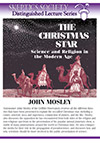 The Christmas Star: Science and Religion
The Christmas Star: Science and Religion
in the Modern Age
(DVD $23.95) with Joh Mosley
-
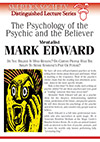 The Psychology of the Psychic
The Psychology of the Psychic
and the Believer Mentalist
(DVD $23.95) with Mark Edward
-
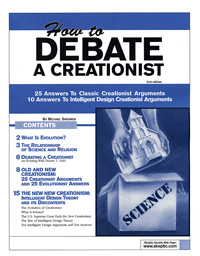 How to Debate a Creationist
How to Debate a Creationist
(27 page booklet $5.00) by Michael Shermer

NEW ON SKEPTICBLOG.ORG
The Free Exercise of Stupidity
Recently, two of the biggest media story brouhahas were Dr. Laura’s N-word gaff and the Ground Zero mosque, both of which commentators insisted are First Amendment issues. They are not. Here’s why…



